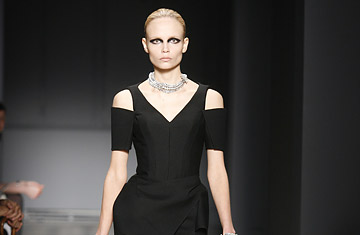
A model on the runway at Balenciaga's fall 2008 show in Paris, France.
Just as the world's financial markets are experiencing a serious mood swing, from exuberance to gloominess, so too is fashion. Enjoy while you can the bright bursts of floral prints sprouting up on department-store racks this spring. Come fall, fashion will follow the downward spiral of home values and investment portfolios, as designers embrace restraint with a dark palette and severe silhouette. As Amy Winehouse would so aptly croon: Back to black.
Historically speaking, fashion trends and tastes often serve as early harbingers of economic change. In the booming, pre-Crash 1920s, flapper hemlines bounced giddily to the knee before falling down to the ankles in the depressed 1930s. The 1960s' youthquake, complete with postage-stamp-size miniskirts, heralded a similar stylistic ebullience before the oil crisis of the 1970s plunged fashion back into an earnest, hippie frame of mind.
The current shift back to black has none of the elements of the sloppy secondhand-Rose ethos of early 1990s' grunge. This time around, fashion's mood swing has a decidedly sharper edge, as designers like Nicolas Ghesquière of Balenciaga, Alber Elbaz of Lanvin and Narciso Rodriguez are trading in last season's brights for severe black cocktail dresses and structured suits. At Yves Saint Laurent, designer Stefano Pilati dressed his models in black bowl-cut wigs and black lipstick to give his simply spliced jackets and tunic dresses a somber, graphic edge. Even Christian Lacroix, famous for his flamboyant use of color, opened his fall show with a parade of models in all black.
"Of course, black is like a mask," says Lacroix, who calls this shift in sensibility a new minimalism. "The new pureness of lines centered on cut rather than decoration, the laser geometry of shapes and silhouettes are all maybe signs of a graphic protection linked unconsciously to recession, just like at the end of the '80s." Like Lacroix, Ghesquière was channeling a more austere sensibility in his Balenciaga collection, which, he said, was inspired by film noir, specifically the actress Simone Signoret's hard-edged look in the 1955 movie Les Diaboliques.
More recent films, like Tim Burton's Sweeney Todd, have also inspired the somber palette. "We're seeing a lot of dark movies these days, and they definitely influence the color story," says Leatrice Eiseman, executive director of the Pantone Color Institute. "Black is always the color people rely on most often in tough times, especially if they're going to spend on big-ticket items." Eiseman, who prepares an annual color forecast for the fashion and home markets, says black will most likely be included in Pantone's selection of the top 10 colors of 2008. "Psychologically, it's also the color people wrap themselves in to become impervious to the outside world. It's a security blanket," she adds.
Black is seeping into the beauty and home markets too. Baccarat just introduced a collection of black crystal goblets, and Chanel Beauté's black satin nail polish is one of the brand's best-selling products. Costume jewelry from Lanvin, a fashion insider must-have, features black ribbons and stones. French perfumer Kilian Hennessy, who introduced a fragrance collection last November called By Kilian, has set himself apart from the trend of transparent scents by introducing a more complex and mysterious composition called L'Oeuvre Noire.
But some designers don't see the dark shift in palette and mood as reason for despair. "I think it's more of a reflection of practicality and reality," says Rodriguez. "When times get tough, people want things that are real and lasting. Black is certainly reflective of that. It's what you can bank on, and it's the most elegant color." And what woman, regardless of her economic situation, doesn't want to look elegant?
